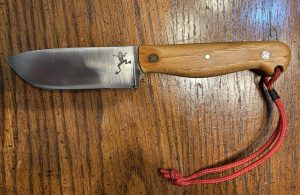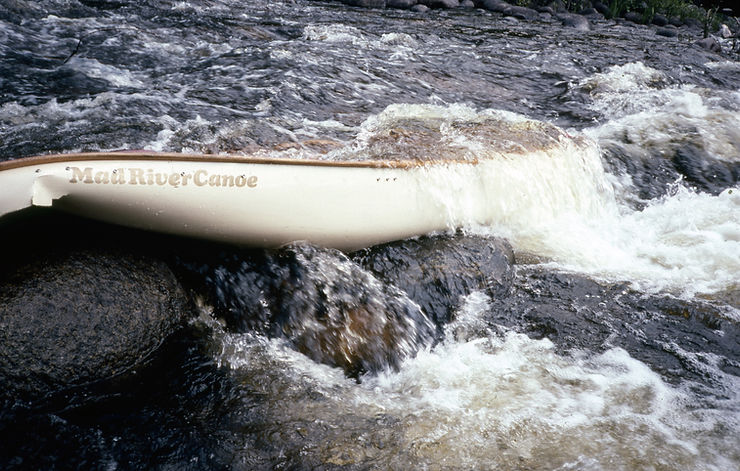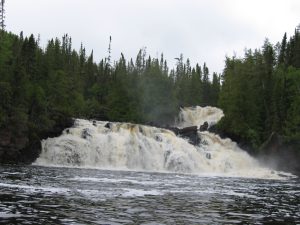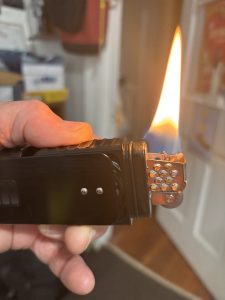
HOW TO DIE ON A CANOE TRIP!

Ask folks what they fear most about canoeing a wild river where help is an airplane ride away and you’ll probably get these answers–in roughly this order:
FEAR #1: Bears! They’re afraid they’ll get eaten alive by one! Or, a bear will get their food!
FEAR #2: They fear they will paddle over a falls or drown in a rapid!
FEAR #3: Getting lost. Many people canoe the same route every season, claiming it’s because the fishing or campsites are great. Truth is, they probably don’t know how to navigate and fear leaving the beaten path.
FEAR #4: Some fear that bugs will drive them mad!
FEAR #5: Being struck by lightning!
FEAR #6: Capsizing in a rapid and wrapping your canoe, or damaging it beyond repair.
These fears are rationale, but none of the events are likely to happen. Here’s my take on them along with some things that you really should worry about!
BEARS

Black bears: I’ve had dozens of encounters over the years; five were cause for concern. In each case I squarely faced the bear and “talked to him” (really!). In less than a minute, the bear ran away.
Grizzlies: Most of the grizzlies I’ve seen on my northern trips high-tailed into the bush as soon as they saw me. There were two exceptions: The scariest was in 1984 along the Hood River, Nunavut. I was photographing a huge herd of caribou, when three grizzlies (mom and two cubs) spotted me and galloped towards me. I think they thought I was a baby caribou. I was not armed so I flattened into the tundra, assumed a protective dead-quiet fetal position and prayed they’d go away. They did!
Polar bears: I’ve had 11 polar bear encounters on my trips to Hudson Bay, all on the North Knife and Caribou Rivers in Manitoba. Once, a bear chased our canoes across the river several times and followed us downstream for about a mile; another time, a female bear and her cub curiously came into our camp. We fired a shot over her head. She stopped and looked up quizzically. I spoke quietly to her and seconds later she turned and ran away, cub in tow. I don’t think our lives were seriously in danger in any of these encounters.

Guns and bears: Admittedly, it is wise to go armed (that is, ONLY if you’re competent with guns) when canoeing among the big bears, but even without a gun, if you keep your wits about you, you’ll probably be okay. Bears respond to your body language: If you look, talk or act frightened, they will take the upper hand. But if you act in control–but not a threat–they will usually leave you alone. The real value of a firearm–and to a lesser extent, pepper spray–is that it sublimates your fear and allows you to talk quietly and confidently.

Polar bear patrol–mouth of the North Knife River on Hudson Bay. Cliff in photo.
Bottomline? Yes, you could be mauled by a bear, but it is way down the list of things that are likely to happen.
PADDLE OVER A FALLS OR DROWN IN A RAPID
In all the canoe trips I’ve made, I cannot recall a single instance of a canoe going over a waterfall. Yes, we’ve had close calls and capsizes, but people were rescued quickly. If you’re wearing suitable clothing and a PFD, your chances of drowning in a rapid are small. You can hear the sound of rushing water some distance away, and your ears quickly become attuned to the gurgle of riffles and the thunder of dangerous drops. When you see dancing horse-tails ahead, you backferry to shore or into an eddy for a closer look. Then, you scout the rapid. If it looks doable, you run it. If not, you line or portage!

Manitou Falls, Fond du Lac River, Saskatchewan
Most rapids occur where the river narrows so a capsized swimmer usually doesn’t have far to swim to shore. Generally, the most experienced team runs the drop first so that less experienced teams can choreograph the route. The next most experienced crew runs last, with an eye for helping boats in trouble. Yes, you can drown in a rapid or paddle over a falls, but like “bears”, it’s down the list of things that will probably happen.
GETTING LOST
Daniel Boone was once asked if he’d ever been lost. He thought mightily then replied, “Never lost, just a mite confused once for three days”. Every tripper–from novice to expert–has become confused from time to time. My longest period of “confusion” (before the days of GPS) was a full day. Where? In the delta of the North Knife River, Manitoba. Confusion occurs frequently enough on northern canoe routes that most experienced paddlers assume it’s just part of the “wilderness tripping game”.
Yes, you will become confused from time to time as you thread your way across big, complex lakes. But unless you do something really stupid, no harm will come from it and you’ll eventually find your way.
BUGS
It has been calculated that an acre of swarming bugs in the high Arctic could drain your blood in about three days! This said, it won’t happen if you bug–proof your body and your camp. Despite the advent of new chemicals, DEET still works best, as do head nets and body nets (like the Susie Bug-net designed by my wife, Sue Harings), and fully-netted tarps and tents. Bugs may drive you batty, but you won’t die from them. And if you go prepared, you’ll be reasonably comfortable.

BEING STRUCK BY LIGHTNING
During a storm along the Gull River (Ontario) my friend’s canoe was nearly struck by lightning as it approached what he thought was the “safety of shore”. The top of a tall birch tree exploded and sent debris raining down on the canoe. The crew was very lucky. Lightning is a more realistic danger than the others listed above, but in the scheme of things, it’s still down the list.
The oft-quoted advice to “get to shore as soon as lighting strikes”, is more theoretical than practical. High winds whip up waves which can send your canoe crashing into a rocky beach. Best stay farther out in the water where you have control.
A cone-of-protection extends outwards about 30 degrees from the top of the tallest tree. Stay within this cone but not so close that lightning may jump from the tree to you. If lightning flashes your camp, sit up on your foam pad, knees pulled to chest…and hope. This position will minimize burns if lightning strikes your tent or a root that goes beneath it. Outdoors books recommend that in a lightning storm you should leave your tent and huddle in a protected low area. Right! I’ve never known anyone to do this. Exiting a nice warm sleeping bag and protective tent in a howling storm is politically correct but impractical.

CAPSIZING IN A RAPID AND WRAPPING OR DAMAGING YOUR CANOE BEYOND REPAIR.
Those who regularly canoe difficult rivers have plenty of stories about canoe-wraps and damaged boats. But with rare exceptions, and sufficient muscle, they are usually able to salvage the canoes. If you have the right repair materials (fiberglass, epoxy, duct tape, wire, clamps) you can usually repair a severely damaged canoe to “paddleable condition”. Ask Rob Kesselring about the Mad River solo canoe a client wrapped in a rapid on the Rio Grande River. Rob fixed the boat “well enough” to finish the trip. Afterwards it went out with the trash–it just wasn’t worth fixing.
THE REAL DANGERS ARE…
CAPSIZING ON OPEN WATER
This one heads the list of real dangers. Capsize far from shore on a cold wilderness lake and your life may end right now. Yes, we all know it’s wise to stay near shore when canoeing big, brawny lakes. But sometimes, we take chances. One that haunts me is when we were canoeing the Tha-anne River in the Canadian province of Nunavut. We were pinned down by high winds on Hyde Lake. Hyde is a roughly round lake, about six miles in diameter. There are no islands or bays to break the wind. Around 4 AM on our third day of imprisonment, the wind stopped and we began the day’s paddle. We had about 31 miles to go to reach the place where our floatplane would pick us up. He would be coming just after sunrise the next morning (these were the days before satellite phones and messengers). The safer choice was to follow the shoreline 25 miles around Hyde Lake. The alternative was to paddle six miles straight across it. Fifty-five miles in one day would be impossible; 31 miles were doable–that is, if the wind held. We chose the shorter route, despite the danger of being on open water. When we were half-a-mile from the lake outlet, the wind came up with a vengeance. Luckily, we made it to shore just in time. We completed the 31 miles and exited the river on schedule the next morning.
Every canoeist has similar stories and they’re not proud of them. Still, capsizing on open water ranks number one on the list of “how to die on a canoe trip.”
STORMS
A major storm can wreak havoc with your camp, more so if you’re on the tundra where there are no trees to break the wind, or you’re deep in the Ontario bush where big winds send trees crashing down. You absolutely, positively must know how to batten down your tent and tarp so it will stay put in the heaviest blow. You must have a seriously wind-stable tent and the skill to pitch tarps that won’t blow down. My video, “The Forgotten Skills” details the procedures.
BECOMING LOST ON A PORTAGE.
This happened to my wife, Susie along the MacFarlane River, Saskatchewan. Somehow, she got off the trail and couldn’t find it. Fortunately, she did not continue on. She set up a bivouac camp, blew her whistle and stayed put. An hour later, I found her. Moral? Always have these things on your body at all times: knife, lighter/matches, whistle, compass, bug dope, insect head-net. Some colored plastic surveying tape may be useful.
CAPSIZING AND LOSING ESSENTIAL GEAR ON A REMOTE WILDERNESS RIVER.
I can recall two occasions where canoes have capsized and the paddlers lost essential gear. On one trip, a canoe lost ALL four of their paddles. Fortunately, we had five boats and paddles to spare. Yes, everyone should bring TWO paddles; one extra per boat isn’t enough. Another case (not my trip): the canoe carrying the cook-set capsized and all was lost. The crew had food but no way to prepare it. Moral? Double-up on important things, and don’t put them in the same canoe! BWCA paddlers put all their food in one pack and haul it into a tree. Experienced canoeists never put all their eggs in a one basket!
MAJOR CAR PROBLEMS
Many years ago, while on our way to the Cree River in Saskatchewan, the tongue on my trailer broke; the trailer flipped over and an iron support bar sliced my then new Old Town Tripper canoe in half. We drove to a nearby gas station where–can you believe(?)–there was an aircraft welder gassing up his truck. He said he was the only aluminum welder in Saskatchewan. He welded the tongue and 30 minutes later we were on our way, minus one canoe. There were no rental canoes in our jump-off town of LaRonge. But to our amazement, we ran into the Canadian Mad River rep who lent us a canoe for the trip. Moral? An auto mechanic may be the most important person on a canoe trip!

HYPOTHERMIA
This is a concern everyone should take seriously. Every north country paddler has tales of someone who has become hypothermic due to weather or cold water immersion. Be prepared! This one heads the list of “How to die on a canoe trip!”
MY TWO DEATH-DEFYING EXPERIENCES!
My closest call was on the Clearwater River in Alberta when a float plane nearly ran over our canoe. The plane was coming around a bend, going too fast to shut down and too slow to take off. As the plane cleared the water, a pontoon missed our heads by about three feet.
My second close call was along the Thlewiaza River, in Canada’s Northwest Territories. Our canoe was snugged against the side of a low (about 10 feet high) canyon (we were studying the rapid ahead). A herd of around 1,000 caribou mingled above us, waiting to swim across the river. The alpha male strutted back-and-forth, looking for a good place to cross. When he found one, he jumped into the river, and over us–his hooves barely missed Susie’s head! A minute later, the herd followed suit and there was loud splashing as the animals swam across. It was quite a rush.
So…of all the things that could have possibly killed me on my northern adventures, the most frightening were a taxiing float plane and a jumping caribou. Yes, there are a lot of things that can maim or kill you on a canoe trip, but the real dangers are seldom what you imagine.
—————
*My flagship book, CANOEING WILD RIVERS, 5th Edition, contains a wealth of advice on how to safely canoe difficult rivers.
*My teen book, JUSTIN CODY’S RACE TO SURVIVAL! mixes a fictional wilderness survival tale with practical outdoor tips everyone should know–a first for books of this type. Adults love it too! Now available as an audio book!

